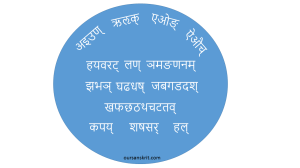 A short YouTube version is available here. [Expand to the full article to be able to click on the link].
A short YouTube version is available here. [Expand to the full article to be able to click on the link].
In the previous lessons, lesson 28 and lesson 29, we looked at the perfect tense, called liṭ लिट् by the Sanskrit grammarians.
In this lesson we will look at one more paradigm of the perfect, the perfect participle and the periphrastic perfect.
Paradigm
The perfect active conjugation of the root √as √अस् (“be”) which is employed as an auxiliary in the periphrastic perfect, which we will learn about later in this lesson.
| āsa आस | āsatuḥ आसतुः | āsuḥ आसुः |
| āsitha आसिथ | āsathuḥ आसथुः | āsa आस |
| āsa आस | āsiva आसिव | āsima आसिम |
Perfect Participles
The perfect active participle is formed by adding vāṃs वांस् to the weak stem of the perfect conjugation (as, for example, seen in the 3rd person plural active of the conjugation). Thus we get bubudhvāṃs बुबुध्वांस्, ninīvāṃs निनीवांस्, cakr̥vāṃs चकृवांस् etc. Monosyllabic weak stems take the union vowel i इ. So, we get dadivāṃs ददिवांस्, tenivāṃs तेनिवांस्, ūcivāṃs ऊचिवांस् etc.
[The vāṃs वांस् is contracted to uṣ उष् in the weakest cases and is replaced by vat वत् in the middle cases]
These are declined in the masculine and neuter as given in the reference.
In the feminine, the form ends in uṣī उषी (instead of vāṃs वांस्) and is declined like ī ई ending feminines as given in the reference.
As an example let us take the perfect participle of √vid √विद् “know”. The perfect participle form is vidvāṃs विद्वांस् (“someone who knows”).
Masculine:
vidvān विद्वान्, vidvāṃsau विद्वांसौ, vidvāṃsaḥ विद्वांसः
vidvāṃsam विद्वांसम्, vidvāṃsau विद्वांसौ, viduṣaḥ विदुषः
viduṣā विदुषा, vidvadbhyām विद्वद्भ्याम्, vidvadbhiḥ विद्वद्भिः
etc.
Neuter
vidvat विद्वत्, viduṣī विदुषी, vidvāṃsi विद्वांसि
vidvat विद्वत्, viduṣī विदुषी, vidvāṃsi विद्वांसि
etc.
Feminine
viduṣī विदुषी, viduṣyau विदुष्यौ, viduṣyaḥ विदुष्यः
etc.
The perfect middle participle is formed by adding āna आन to the weak stem. Examples are: bubudhāna बुबुधान, ninyāna निन्यान, dadāna ददान, tenāna तेनान, ūcāna ऊचान etc. It is declined like the “a” masculine and neuters and the “ā” feminines. The middle participle is hardly ever used.
Note: In classical Sanskrit, this is it about the perfect. However, in ancient Sanskrit there is much more. The perfect tense (the perfect system ) shows its own modes (like imperative, subjunctive and optative) and also an augment preterit – the pluperfect (like the imperfect is to the present). These have been lost in classical Sanskrit. We will touch upon these in later lessons.
The periphrastic perfect
The perfect formation we learned so far is called the reduplicated perfect (for obvious reasons). There is another perfect formation which is commonly used in classical Sanskrit. Like the periphrastic future (see lesson 27), it uses an auxiliary. It is formed by adding an auxiliary to the accusative of a noun stem in ā आ. The auxiliary used is the reduplicated perfect tense of √as √अस् “be” , (or rarely) √bhū √भू, in the active only and √kr̥ √कृ, in the active and the middle.
The periphrastic perfect is used instead of the reduplicated perfect for all verbs beginning with a long vowel, or with a short vowel followed by two consonants.
It is also used by all class 10 roots.
[It is also used for all secondary conjugations like causatives, denominatives, intensatives, desideratives etc. We will learn secondary conjugations later on.]
Note that a verb stem normally may take either the reduplicated perfect or the periphrastic perfect. But, never both. [There are some exceptions.]
Examples: Let us take the root √ās √आस् “sit”.
In the active, we can have
āsām āsa आसाम् आस, āsām āsatuḥ आसाम् आसतुः, āsām āsuḥ आसाम् आसुः etc.
OR
āsāṃ cakāra आसां चकार, āsām cakratuḥ आसाम् चक्रतुः, āsāṃ cakruḥ आसां चक्रुः etc.
In the middle,
āsāṃ cakre आसां चक्रे, āsām cakrāte आसाम् चक्राते, āsāṃ cakrire आसां चक्रिरे etc.
Note: The periphrastic perfect does not have participles.
The perfect passive
The perfect passive (for both the reduplicated perfect and the periphrastic perfect) is identical in form to the middle.
Uses of the perfect
As mentioned before, in classical Sanskrit, the perfect, the aorist and the imperfect are used interchangeably for past actions.
This is the end of lesson 30. In this lesson we concluded the treatment of the perfect tense.
[…] the previous lessons, lesson 28 , lesson 29 and lesson 30, we looked at the perfect tense, called liṭ लिट् by the Sanskrit […]
[…] the previous lessons, lesson 28, lesson 29, and lesson 30, we looked at the perfect tense, called liṭ लिट् by the Sanskrit grammarians. In lesson […]
[…] saw in lesson 30, that the perfect active participle is formed by adding the suffix vāṃs वांस् to the […]
[…] lesson 30 for the use of the perfect […]
[…] its modes, its participle and an augment perterit, the pluperfect. In lessons 28, 29 and 30, we looked at the indicative and the participle perfect […]